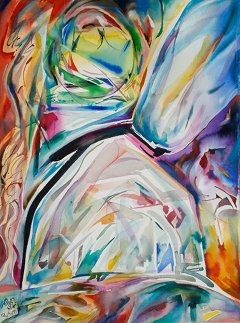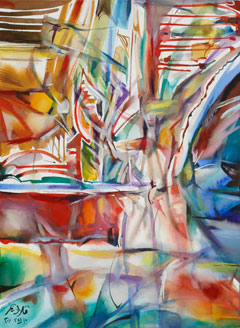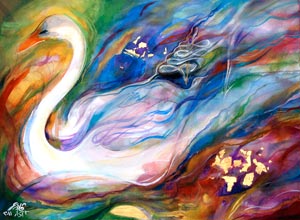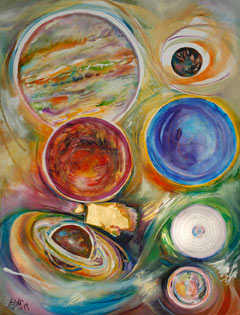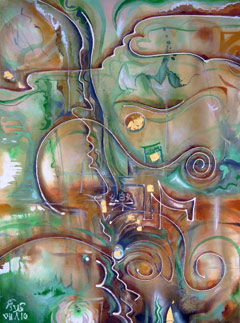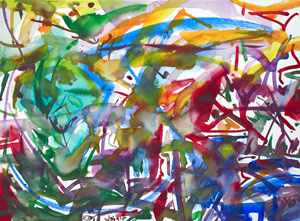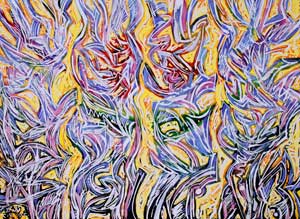PAINTING THE MUSIC
Vladimir Tamari
FRANCK
|
October 2010. I enjoyed making this painting and faced none of the difficulties of the music clashing with the pace of my work, as in the second Brahms painting. Cesar Franck's music is undemanding yet interesting and enjoyable and has a moving honesty of feeling with a layer of protest or irritability that engages the listener. His organ pieces alternated between quiet interludes and frankly bombastic outbursts that made me smile, because they reminded me of an incident of long ago. When Mariam was around two and half years old we were attending an organ recital at a church, and the fare included a piece by a modern French composer. I am almost sure it was by Franck. Following an almighty volley of chords my precocious child turned and whispered to me in Japanese "onara mitai!" - i.e. 'its like a fart'. Unable to contain myself from laughing aloud I took her hand and left the church, even though she wanted to stay. This of course is not to belittle Franck, a great and beloved teacher of composition at the Paris Conservatoire who influenced a generation of French musicians. Once Liszt heard his improvisations on the pipe organ and likened them to Bach's. |
BACH (6)
|
December 2010. This painting was made in about three and a half hours the afternoon of the 10th, not counting a late lunch break and a short stroll around the block when I took photos of the bright sunlit yellow leaves of the ginkgo trees lining both sides of the street). While painting I listened once to the 3 CDs of The English Concert's recording of Bach's complete harpsichord concertos (BWV 1052-1058 with Trevor Pinnock and others of The English Concert). The music is brilliant and generally sprightly in spirit, and the lack of sustainable notes in a harpsichord seemed to have made it necessary for Bach to fill every nook and cranny of the musical space with cascades of short notes. Besides which the later concertos require two, three and lastly four harpsichords playing together! This is exciting music performed beautifully - I have loved two of these concertos since my youthful days in Ramallah - so instead of the careful leisurely transparent strokes I used in the Franck painting, I worked furiously in “real time” in a slap-dash manner, attempting to put down my reactions in shapes and colors without wasting a minute to consider the result. In any case for some time now I have been having vision problems, cataracts reducing everything I see from a distance to a slightly unfocused hazy version of what would normally be seen. So while the shapes in the painting are crisp and very strongly colored (as I could tell from looking closely at the paper), I saw the painting as a whole in pleasant pastel tones. |
TCHAIKOVSKY (2)
|
February 2011. After a couple of years of gradually failing vision due to old-age cataracts, I could only see badly out-of-focus shapes and hazy yellowish colors with the left eye; the right eye was only slightly better. For an artist it was like being half-alive. Luckily sharp vision was possible when looking close-up at things, so I continued painting but lacked confidence in the colors I was using and seeing. One day I was near a local concert hall where ballets where being performed, including excerpts from Prokofieff's Romeo and Juliet. I walked in but everything was so out of focus the only way to see the dancers distinctly was by peering through the pinholes found on a telephone card - an optical diffraction phenomena I had studied many years ago. The ballet was so beautiful I resolved right there and then to have the feared operations necessary to correct this problem. After the initial visits to the eye clinic I chose to listen and paint to Tchaikovsky's exhilarating and soothing ballet music. Starting with Swan Lake I sketched the large swan, but left off painting for some days. During the first operation I enjoyed seeing soft aurora-like colors as the doctor operated, and I could hear some faint Japanese pop songs - a sort of serendipitous visual music. When the bandage was taken off in the clinic the next day I was stunned at how well I could now see with that eye - everything looked sharp, the colors clean and brilliant. Pristine sight was restored to the second eye a week later. What had previously appeared muddy and indistinct was now seen sharply defined in brilliant subtle colors and in 3D. Vision was reborn! I was ecstatic and enjoyed a movable feast of infinite shades of fresh blues, violets reds oranges, yellows and greens. Blacks that used to appear as a uniform dull gray, now regained their velvety depths. I could see stars in the night sky! I was especially happy to look at white objects including the snow that fell the day of the operation. Later during a walk I saw a piece of white cardboard on the ground and it seemed as a very precious object. I picked it up, and still have it, but now I do not know what to do with it! Celebrating with Tchaikovsky's music I repainted the swan and was satisfied with the bright colors and undulating lines to finish the painting. There was no need to listen to this great composer's two other famous ballets Sleeping Beauty and The Nutcracker Suite. |
HOLST
|
May 2011. Although Gustav Holst wrote more than 200 compositions this English composer and friend of Vaughn Williams is chiefly remembered by the public for just one piece. The Planets (Op. 32), the lively orchestral suite of seven parts, was a musical tribute to our neighbors in the solar system, although the references to them were astrological not astronomical. For example the first movement is entitled Mars, Bringer of War (which I painted in reds) , followed by Venus Bringer of Peace (blue). Coincidentally the orchestral version of The Planets was first performed just before the end of World War I. The other planets were likewise painted using invented colors except for Jupiter ( the largest one top left) which was more or less inspired by the colors of the actual planet). The others are Uranus (top right) Mercury (bottom right) Neptune (just above it) and Saturn (bottom left). I suppose one can consider the irregular golden shape as Pluto, which was only discovered in 1933 a year before Holst died, but he did not bother writing music for it. In this he seems to have been prescient: a few years ago astronomers decided that Pluto was not a planet after all, just a chunk of ice revolving around the Sun, only a bit larger than many others like it. Holst too may not be one of the seven greatest composers; nevertheless he wrote enjoyable and original music that often included invigorating forays using strange rhythms or languorous melodies. This painting was made mostly listening to The Planets, but while painting the background I also listened to this composer's delightful First and Second Suites for Military Band (Op. 28) , Hammersmith Op.52, St. Paul's Suite Op. 29 and other smaller works. |
CHINESE MUSIC
|
August 2011 China's culture goes back thousands of years - an unimaginable stretch for those of us who are now in the habit of turning to the Internet for instant gratification - news, music, or whatever else may interest us. Having grown up in Palestine with its ancient stones witness to past civilizations and cultures, I understand 'ancient'. I still hanker for the patina of age even after living 40 years in contemporary Japan, a place that idolizes the brand new, but thankfully preserves some of the old. I have a long series of photographs of rust - the occasional forgotten sign crumbling with age, its once garish colors tempered by the the elements and by chemical action. As I started listening to traditional Chinese pieces with titles like Serene Orchid to the Tune of Stone Tablet or the enchanting Feeling In Autumn Beside The Dressing Table the Chinese landscape painting on the CD cover inspired me to limit my palette. Rather than the austere monochromes of the cover, I chose to mimic the traditional sancai (three colors) of Chinese ceramic sculpture dating back to the Tang dynasty. In my watercolor I used burnt sienna and umber, (reddish browns), ochre (yellowish beige), a bright green, with black and white accents and gold foil. I loved the music played on the guquin or qin (an ancient 7-stringed zither), and other instruments, polished and distilled by centuries of musicians each learning from his or her teacher, to satisfy a Confucian ideal - a philosophical 'scholarly' contemplative mood. Music that both soothes and excites by turns. The miracle of it is that despite the straight jacket of such restrictions in terms of technique and allowed expression, the music is so affecting and fresh-sounding. The Chinese character for music is scrawled at the center of my painting. The soft flowing color gradations with scruffy shapes derive from ink landscape paintings, while the bold white lines curling around are from real or imagined details of traditional Chinese furniture or architectural elements and ceramics. Besides the polished court music, I listened to rustic festival music recorded by ethnographers, and to the amazing Beijing Opera (as seen on YouTube) - I am glad I did not start this painting inspired by its exuberant colors and patterns of the makeup and costumes, or the lovely piercing singing of the female singers - that would have inspired a very different painting! |
MOZART (5)
|
September 2011. I made this watercolor painting in 'real time' listening once to each of the four movements of Mozart's Symphony No. 14 in A Major, pausing only to change the water, clean the brush and snap a photo after each movement. A few days before I had been cycling while listening to my ipod headphones (which a recent law in Japan has made illegal) enjoying listening to a complete set of Mozart's symphonies starting with No 1, composed when he was just 8 years old. The music was lovely, technically perfect and brilliant, full of the innocent felicities of childhood joys - Hayden on a chocolate high. When No. 14 came on I realized that here was something new - there was a deeper passion, a sort of urgency and a soaring in the melodies and pace, and a more adventurous display of musical bravura than in the earlier works. I thought I might make a painting to this work, that I later discovered Mozart made when he was 15. I also congratulated myself on my perspicacity (and knowledge of out-dated words) when, having finished the painting, I read that Nicholas Kenyon describes Symphony No. 13 as the last in "conventional mode"— thereafter "we are in the beginnings of a different world." This then was the first hint of the greatness that culminated in Mozart's last three symphonies Nos 39, 40 and 41 - (see my painting of April 2001 Mozart(2) painted to the 40th.) Now my mood reflected the hot summer and the hot and disturbing news - bloody events following the Arab Spring, the simultaneous 10th anniversary of 9/11, and six months after the great earthquake in Japan. And here was this brilliant exciting music of adolescence (the age of rebellion) urging me to splash bold pure colors using one big brush, not pausing to correct or refine the shapes. After one hearing of this short symphony (about 21 minutes) I preferred to keep the painting as it is without further work, leaving the colors and the strokes fresh and spontaneous - a bit disturbing, but true. |
BEETHOVEN (6)
|
November 2011. I made this painting listening to all nine of Beethoven's symphonies in their numbered order. My decision to use masking solution technique with watercolor gave the final picture a somewhat delicate texture like batik or a woodcut - rather different from the fulsome all-enveloping harmonies of Beethoven in full blast. That said I must admit that the music really helped concentrate and limit the brushstrokes and shapes to try to express the utter beauty, power, and - for all its technical sophistication - emotional directness and 'simplicity' of the music. The organization of the painting into four columns - left-to-right, one for each movement - helped concentrate the shapes, but some symphonies had three movements so there was some 'overlapping'. I listened to each symphony twice on successive days, once to lay the masking solution that preserves the color (or at first the white of the paper), and once to lay new color. By the time I reached the Sixth Symphony the painting was practically covered with color and masking. For the last three symphonies I just quickly laid sweeping horizontal color to fill the remaining unpainted 'gaps'. For example the reddish tones in the top center of the painting were done listening to the Ninth Symphony. Finally, removing the messy masking revealed the simple fresh colors of the painting which reflects something of the tremendously healthy spirit of this great composer. It now occurs to me the columns resemble cypress trees that I learned to love in Palestine. The music is too well known and almost universally loved for me to add anything new here - except to mention something Einstein said about Beethoven's music - that it was like a man running about naked! I could not find the exact quote, but I could understand what Einstein, who preferred Mozart's music, meant. This 'uncivilized' image brings to mind the grace and freedom of ancient Greek sculptures and paintings of athletes - an appropriate image for the composer with the famously defiant Olympian spirit. |
